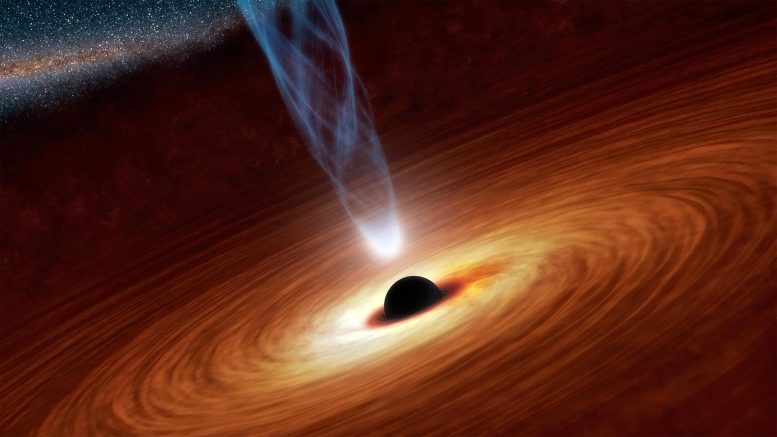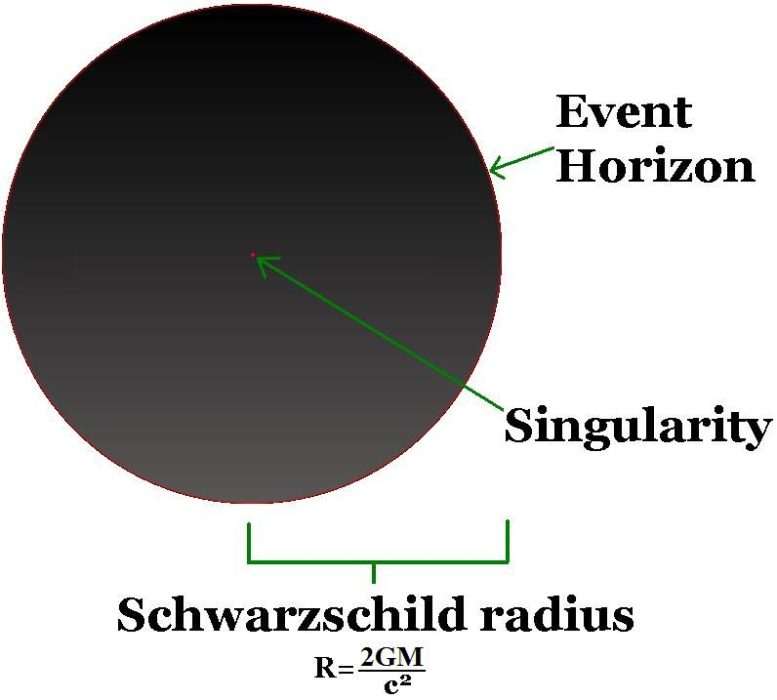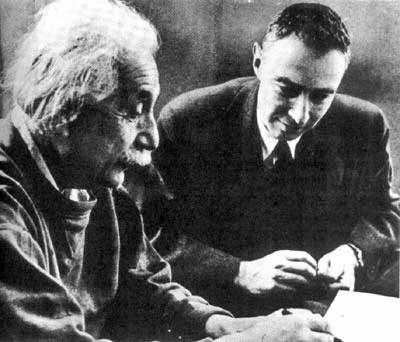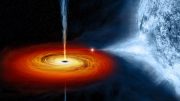
Artist’s concept illustration of a supermassive black hole emitting an x-ray jet. Credit: NASA/JPL-Caltech
Late in 2018, the gravitational wave observatory, LIGO, announced that they had detected the most distant and massive source of ripples of spacetime ever monitored: gravitational waves triggered by pairs of black holes colliding in deep space. Only since 2015 have we been able to observe these invisible astronomical bodies, which at that time could be detected only by their gravitational attraction. Then in a breakthrough in 2019, the Event Horizon Telescope captured an image of a black hole and its shadow for the first time.
The history of our hunt for these enigmatic objects traces back to the 18th century, but the crucial phase took place in a suitably dark period of human history – World War II.
The concept of a body that would trap light, and thereby become invisible to the rest of the universe, had first been considered by the natural philosophers John Michell and later Pierre-Simon Laplace in the 18th century. They calculated the escape velocity of a light particle from a body using Newton’s gravitational laws, predicting the existence of stars so dense that light could not escape from them. Michell called them “dark stars.”
But after the discovery that light took the form of a wave in 1801, it became unclear how light would be affected by the Newtonian gravitational field, so the idea of dark stars was dropped. It took roughly 115 years to understand how light in the form of a wave would behave under the influence of a gravitational field, with Albert Einstein’s General Relativity Theory in 1915, and Karl Schwarzschild’s solution to this problem a year later.
Schwarzschild also predicted the existence of a critical circumference of a body, beyond which light would be unable to cross: the Schwarzschild radius. This idea was similar to that of Michell, but now this critical circumference was understood as an impenetrable barrier.

The Schwarzchild radius. Credit: Tetra Quark/Wikimedia Commons, CC BY-SA
It was only in 1933 that George Lemaître showed that this impenetrability was only an illusion that a distant observer would have. Using the now famous Alice and Bob illustration, the physicist hypothesized that if Bob stood still while Alice jumped into the black hole, Bob would see Alice’s image slowing down until freezing just before reaching the Schwarzschild radius. Lemaître also showed that in reality, Alice crosses that barrier: Bob and Alice just experience the event differently.
Despite this theory, at the time there was no known object of such a size, nothing even close to a black hole. As a result, no one believed that something resembling the dark stars as hypothesized by Michell would exist. In fact, no one even dared to treat the possibility with seriousness. Not until the Second World War.
From dark stars to black holes
On September 1, 1939, the Nazi German army invaded Poland, triggering the beginning of the war that changed the world’s history forever. Remarkably, it was on this very same day that the first academic paper on black holes was published. The now acclaimed article, On Continued Gravitational Contraction, by J Robert Oppenheimer and Hartland Snyder, two American physicists, was a crucial point in the history of black holes. This timing seems particularly odd when you consider the centrality of the rest of World War II in the development of the theory of black holes.
This was Oppenheimer’s third and final paper in astrophysics. In it, he and Snyder predict the continued contraction of a star under the influence of its own gravitational field, creating a body with an intense attraction force that not even light could escape from it. This was the first version of the modern concept of a black hole, an astronomical body so massive that it can only be detected by its gravitational attraction.
In 1939, this was still an idea that was too strange to be believed. It would take two decades until the concept was developed enough that physicists would start to accept the consequences of the continued contraction described by Oppenheimer. And World War II itself had a crucial role in its development, because of the US government’s investment in researching atomic bombs.
Reborn from the ashes
Oppenheimer, of course, was not only an important character in the history of black holes. He would later become the head of the Manhattan Project, the research center that led to the development of atomic weapons.
Politicians understood the importance of investing in science in order to bring military advantage. Consequently, across the board, there was a wide investment in war-related revolutionary physics research, nuclear physics, and the development of new technologies. All sorts of physicists dedicated themselves to this kind of research, and as an immediate consequence, the fields of cosmology and astrophysics were mostly forgotten, including Oppenheimer’s paper.
In spite of the decade lost to large-scale astronomical research, the discipline of physics thrived as a whole as a result of the war – in fact, military physics ended up augmenting astronomy. The US left the war as the center of modern physics. The number of PhDs skyrocketed, and a new tradition of postdoctoral education was set up.
By the end of the war, the study of the universe was rekindled. There was a renaissance in the once underestimated theory of general relativity. The war changed the way we do physics: and eventually, this led to the fields of cosmology and general relativity getting the recognition they deserve. And this was fundamental to the acceptance and understanding of the black holes.
Princeton University then became the center of a new generation of relativists. It was there that the nuclear physicist, John A Wheeler, who later popularized the name “black hole,” had his first contact with general relativity, and reanalyzed Oppenheimer’s work. Skeptical at first, the influence of close relativists, new advances in computational simulation, and radio technology – developed during the war – turned him into the greatest enthusiast for Oppenheimer’s prediction on the day that war broke out, September 1, 1939.
Since then, new properties and types of black holes have been theorized and discovered, but all this only culminated in 2015. The measurement of the gravitational waves created in a black hole binary system was the first concrete proof that black holes exist.
Written by Carla Rodrigues Almeida, Visiting Postdoctoral Fellow, Max Planck Institute for the History of Science.
This article was first published in The Conversation.![]()










A common misconception (even among physicists!) is “Einstein refused to believe in physical existence of Black Holes!”!
No, Einstein refused to believe in physical existence of singularities (0-size/infinite-density objects) & he was actually absolutely right IMHO!
First of all, IMHO, thinking/assuming Black Holes contain singularities (which have zero-size & infinite-density!) is utterly ridiculous!
(Imagine 2 zero-size(!) objects: one of them has the mass of a large star(!) & the other has the mass of a galaxy! This really makes any sense?)
I think progress in theoretical physics is pretty much stuck today, because of this kind of physically out-of-touch thinking!
Assuming that, if anything mathematically/geometrically possible, it is also physically possible!
Assuming that, our universe is made of perfect/ideal mathematical/geometric objects, like 0D points and/or 1D rings/strings etc!
Just like when Kepler wasted many years trying to explain whole celestial mechanics using 5 (perfect!) Platonic Solids!
BHs should/must be made of particles, just like everything else in our universe!
& guess what?: There is only 1 possible/suitable particle then: Planckion!
A particle that has min possible size (Planck length) & max possible density (Planck mass) & so can never be crushed or compressed any further!
A particle that is itself is a micro-BH! (Realize, for example, a Neutron Star is just like a giant neutron!)
A particle that is unstable individually but stable when part of a star (so just like neutron)!